As 10 Steps to a More Mindful Meditation Session takes center stage, this opening passage beckons readers with refreshing subuh lecture style into a world crafted with good knowledge, ensuring a reading experience that is both absorbing and distinctly original.
Embark on a journey towards a more mindful meditation session by exploring the steps Artikeld below, designed to deepen your practice and bring a sense of peace and awareness to your daily life.
Introduction to Mindful Meditation
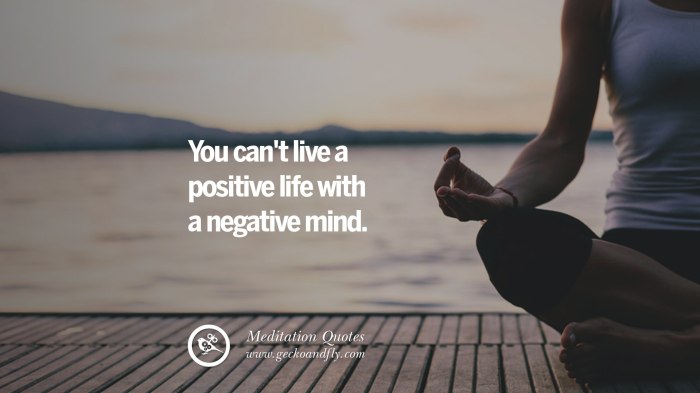
Mindful meditation is a practice that involves focusing your mind on the present moment without judgment. By being fully present and aware of your thoughts, feelings, and sensations, you can cultivate a sense of calm and clarity. This form of meditation has been shown to reduce stress, improve concentration, and promote emotional well-being.Setting intentions before a meditation session is crucial in mindful meditation as it helps you establish a purpose for your practice.
By setting clear intentions, you can direct your focus and energy towards specific goals, whether it’s to reduce anxiety, increase self-awareness, or cultivate compassion.Unlike traditional meditation practices that may involve emptying the mind or focusing on a specific object, mindful meditation encourages you to observe your thoughts and emotions as they arise without getting caught up in them. It emphasizes acceptance and non-judgment, allowing you to develop a deeper understanding of your inner experiences.
Creating a Peaceful Environment
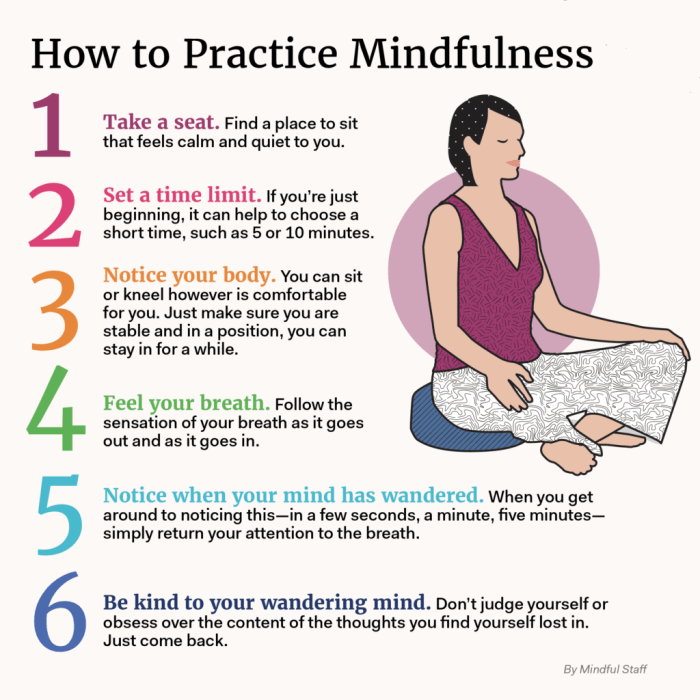
Creating a tranquil space for meditation is essential to enhance the overall experience and help you achieve a deeper state of mindfulness. Eliminating distractions and incorporating elements like lighting and aromatherapy can further elevate your meditation session.
Tips for Setting Up a Tranquil Space
- Choose a quiet and secluded area where you can meditate without interruptions.
- Declutter the space to create a sense of calm and serenity.
- Add elements like cushions, blankets, or a comfortable chair to support your posture during meditation.
Significance of Eliminating Distractions
Distractions can hinder your ability to focus and connect with your inner self during meditation. By eliminating distractions, you can create a conducive environment for deepening your practice.
Enhancing the Experience with Lighting and Aromatherapy
Soft, natural lighting can help create a peaceful ambiance for meditation. Consider using candles, dimmable lights, or natural sunlight to set the mood.
Aromatherapy, through the use of essential oils like lavender or sandalwood, can further enhance your meditation experience by promoting relaxation and reducing stress.
Body Posture and Alignment
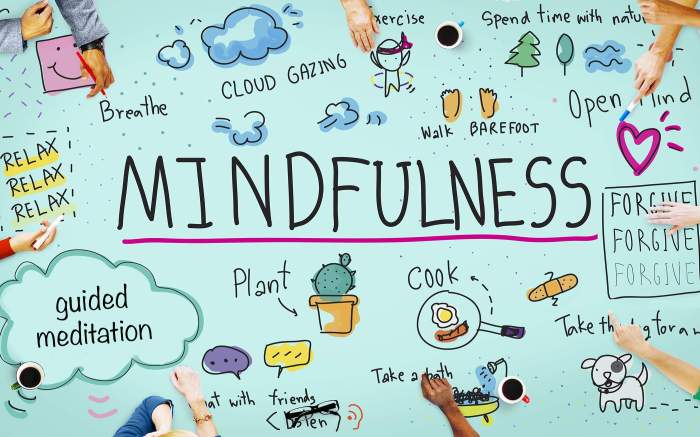
Proper posture plays a crucial role in mindful meditation as it helps in maintaining focus, comfort, and alertness throughout the session. It also ensures that energy flows freely through the body, promoting a sense of balance and harmony.
Sitting Positions for Mindful Meditation
- Cross-legged Position: Sit on a cushion with your legs crossed in front of you. This position helps in grounding your energy and maintaining stability.
- Half Lotus Position: Place one foot on the opposite thigh and the other under the opposite knee. This position promotes openness and relaxation.
- Full Lotus Position: Cross your legs with each foot resting on the opposite thigh. This position enhances concentration and mindfulness.
- Seated on a Chair: If sitting on the floor is uncomfortable, you can also meditate while sitting on a chair with your feet flat on the ground. Just ensure your back is straight and unsupported.
Tips for Maintaining Comfortable Posture
- Keep your spine straight but not rigid, allowing for a natural curve in the lower back.
- Relax your shoulders and place your hands on your lap or knees.
- Rest your head comfortably on your neck, neither leaning forward nor backward.
- Close your eyes gently or maintain a soft gaze to avoid distractions.
- Engage your core muscles lightly to support your posture throughout the meditation.
Breathing Techniques
Breathing techniques play a crucial role in achieving a more mindful meditation session. By focusing on the breath, we can promote relaxation, improve focus, and calm the mind. Deep breathing is particularly effective in reducing stress and anxiety, allowing us to connect more deeply with our inner selves during meditation. In addition, syncing our breath with movement can enhance the overall mindfulness practice, creating a more harmonious mind-body connection.
Exploring Different Breathing Exercises
There are various breathing exercises that can help us relax and center ourselves during meditation. Some common techniques include:
- Diaphragmatic Breathing: Also known as belly breathing, this technique involves breathing deeply into the diaphragm, allowing the abdomen to expand with each inhale and contract with each exhale.
- Box Breathing: This technique involves inhaling for a count of four, holding the breath for a count of four, exhaling for a count of four, and holding the breath again for a count of four. This pattern creates a square or box shape, hence the name.
- Nadi Shodhana (Alternate Nostril Breathing): This technique involves alternating the breath between the left and right nostrils, which can help balance the body’s energy and calm the mind.
The Importance of Deep Breathing
Deep breathing is essential for calming the mind and reducing stress levels. When we take slow, deep breaths, we activate the body’s relaxation response, lowering heart rate and blood pressure while promoting a sense of calm and well-being. Incorporating deep breathing into meditation can enhance the overall experience and help us stay present in the moment.
Syncing Breath with Movement
Syncing our breath with movement during meditation can deepen our practice and cultivate mindfulness. By coordinating the breath with specific movements, such as inhaling as we raise our arms and exhaling as we lower them, we can create a more fluid and focused meditation session. This synchronization helps us stay grounded in the present moment and enhances the mind-body connection.
Cultivating Awareness and Presence: 10 Steps To A More Mindful Meditation Session
When it comes to mindfulness meditation, cultivating awareness and presence is key to deepening your practice. By bringing your attention to the present moment, you can enhance the benefits of meditation and increase your overall sense of well-being.
Body Scanning Technique
One effective method to increase mindfulness is through the practice of body scanning. This involves systematically directing your attention to different parts of your body, starting from the top of your head down to your toes. By focusing on each body part, you can become more attuned to physical sensations, tensions, and areas of relaxation. This technique helps you develop a greater awareness of your body and promotes a sense of grounding and presence.
- Begin by finding a comfortable position for meditation, either sitting or lying down.
- Close your eyes and take a few deep breaths to center yourself.
- Start by bringing your attention to the top of your head and slowly move down, noticing any sensations or feelings in each body part.
- Observe any areas of tension or discomfort without judgment, simply acknowledging them and allowing them to release.
- Continue scanning your body until you reach your toes, taking note of how each part feels and any changes that occur.
- Take a few moments to focus on your body as a whole, feeling the connection between each part and the present moment.
Observing Thoughts and Emotions
During meditation, it’s common to experience a stream of thoughts and emotions. Instead of getting caught up in these distractions, mindfulness practice involves observing them without judgment. By cultivating a sense of detachment from your thoughts and emotions, you can develop a deeper awareness of your inner landscape and learn to let go of unhelpful patterns.
Remember, you are not your thoughts or emotions. They are simply passing phenomena that you can observe and let go.
- When a thought arises, simply acknowledge it and gently bring your focus back to your breath or body sensations.
- Avoid labeling thoughts as good or bad, right or wrong. Instead, see them as neutral mental events that come and go.
- If strong emotions surface, allow yourself to feel them without getting carried away. Observe the physical sensations they create in your body and let them pass naturally.
- Practice self-compassion and kindness towards yourself as you navigate the ups and downs of your inner world.
Guided Meditation and Visualization
Guided meditation is a practice where an individual is led through a meditation session by a trained practitioner or through recorded audio. This technique helps beginners or those struggling to focus by providing verbal instructions and prompts throughout the meditation. Guided meditation often incorporates visualization techniques to deepen the meditation experience and enhance relaxation.
Visualization Techniques
- One common visualization technique involves imagining a peaceful place in nature, such as a beach or a forest. Focus on the sights, sounds, and sensations of this place to create a sense of calm and relaxation.
- Another visualization technique is to picture a ball of light or energy at the center of your body. As you breathe deeply, imagine this light expanding with each inhale and filling your entire being with positivity and tranquility.
- You can also visualize a specific goal or intention during your meditation practice. Picture yourself achieving this goal in vivid detail, engaging all your senses to make the visualization as real as possible.
Enhancing Focus and Relaxation
Guided meditation can enhance focus and relaxation by providing a structured framework for the practice. The verbal cues and instructions help keep the mind from wandering and bring attention back to the present moment. Visualization techniques used in guided meditation can create a more immersive experience, allowing the practitioner to fully engage with their senses and emotions. Overall, guided meditation can be a powerful tool for deepening mindfulness, reducing stress, and improving overall well-being.
Incorporating Mindful Movement
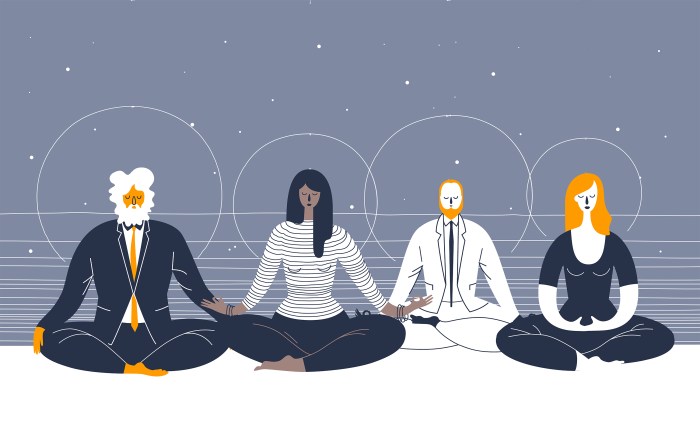
Incorporating mindful movement into meditation practices can enhance the overall experience by helping individuals connect with their bodies on a deeper level. By engaging in gentle movements, such as yoga or Tai Chi, practitioners can cultivate a greater sense of awareness and presence in the present moment.
Benefits of Mindful Movement
- Improves flexibility and mobility
- Enhances body awareness
- Promotes relaxation and stress relief
Examples of Mindful Movements
- Yoga: A practice that combines physical postures, breathing techniques, and meditation to promote overall well-being.
- Tai Chi: An ancient Chinese martial art that focuses on slow, deliberate movements to cultivate balance, strength, and mental clarity.
Grounding and Connecting with the Body, 10 Steps to a More Mindful Meditation Session
Engaging in mindful movement can help individuals ground themselves in the present moment and establish a deeper connection with their bodies. By focusing on the sensations and movements of the body, practitioners can enhance their overall mindfulness practice and foster a greater sense of embodiment.
Practicing Gratitude and Loving-Kindness
Incorporating gratitude and loving-kindness practices into meditation sessions can have profound effects on our mental, emotional, and physical well-being. These practices help cultivate a positive mindset, foster compassion towards ourselves and others, and promote overall mindfulness in our daily lives.
Cultivating Gratitude
Practicing gratitude involves acknowledging and appreciating the positive aspects of our lives, no matter how small they may seem. This can be done through journaling, reflecting on moments of joy, or simply expressing thanks for the blessings we have.
- Acknowledge the good: Take time to reflect on the things you are grateful for, whether it’s your health, relationships, or opportunities.
- Gratitude journal: Keep a journal where you write down things you are thankful for each day, fostering a sense of appreciation and mindfulness.
- Express thanks: Show gratitude towards others by saying thank you, sending a note of appreciation, or performing acts of kindness.
Cultivating Loving-Kindness
Loving-kindness meditation involves sending well-wishes and positive intentions towards oneself and others. This practice helps develop empathy, compassion, and a sense of interconnectedness with all beings.
- Loving-kindness phrases: Repeat phrases such as “May I be happy, may I be healthy, may I be safe, may I live with ease” to cultivate feelings of self-love and compassion.
- Extending loving-kindness: Expand your practice to include loved ones, acquaintances, and even difficult individuals, sending them wishes of well-being and happiness.
- Visualize positive outcomes: Imagine a world filled with love, kindness, and compassion, fostering a sense of unity and interconnectedness with all beings.
Improving Well-Being
Practicing gratitude and loving-kindness can have a profound impact on our overall well-being, leading to increased happiness, reduced stress, and improved relationships with ourselves and others. By incorporating these practices into our meditation sessions, we can cultivate a more positive and compassionate outlook on life.
Managing Distractions and Inner Critic
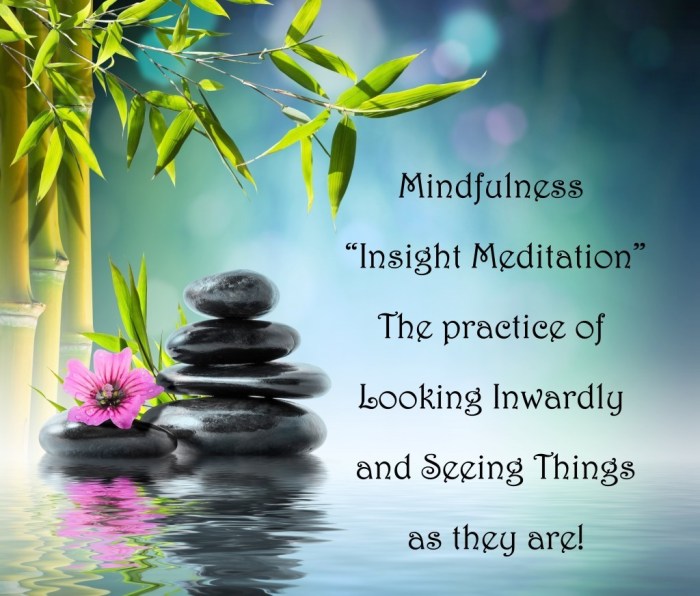
When practicing mindful meditation, distractions can often arise, pulling your focus away from the present moment. Additionally, the inner critic may start to chime in with negative thoughts and judgments. It is important to have strategies in place to manage these distractions effectively and cultivate a sense of self-compassion and patience.
Strategies for Dealing with Distractions
- Acknowledge the distraction without judgment, simply noting its presence.
- Gently guide your focus back to your breath or chosen point of focus.
- If the distraction persists, explore it mindfully before returning to your practice.
- Practice non-attachment to thoughts and emotions, allowing them to pass without getting caught up in them.
Acknowledging and Quieting the Inner Critic
- Recognize when the inner critic arises, observing its presence without engaging with its negativity.
- Offer yourself words of kindness and compassion, reassuring yourself that it is okay to have these thoughts.
- Refocus your attention on your breath or body sensations to quiet the inner critic’s voice.
- Remind yourself that you are not your thoughts and that self-compassion is key to overcoming self-criticism.
Importance of Self-Compassion and Patience
- Self-compassion allows you to be kind to yourself in moments of difficulty or distraction, fostering a sense of understanding and acceptance.
- Patience is essential in meditation practice, as it takes time and effort to cultivate mindfulness and overcome distractions.
- By practicing self-compassion and patience, you can build resilience against the inner critic and distractions, creating a more peaceful and focused meditation experience.
Reflection and Integration
Reflecting on your meditation practice is a crucial step in deepening your mindfulness journey. Integration of mindfulness into daily activities helps to maintain a sense of presence throughout the day. Setting realistic goals ensures consistency in your meditation practice.
Journaling or Reflection
After each meditation session, take a few moments to journal your thoughts and experiences. Reflecting on how you felt during the practice, any insights gained, or challenges faced can provide valuable feedback for your growth.
Integrating Mindfulness into Daily Activities
Find ways to bring mindfulness into your everyday routine. Whether it’s mindful eating, walking, or even doing household chores, practice being fully present in the moment. This can help cultivate a deeper sense of awareness and peace throughout the day.
Setting Realistic Goals
When establishing a meditation practice, it’s essential to set realistic goals that align with your schedule and lifestyle. Start with shorter sessions and gradually increase the duration as you build consistency. Setting achievable goals will help you stay committed to your practice.
Closure
In embracing the 10 Steps to a More Mindful Meditation Session, may you find a path that leads to greater mindfulness, clarity, and inner peace. Incorporate these practices into your daily routine and witness the transformative power of meditation unfold in your life.